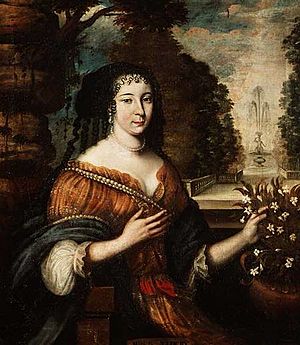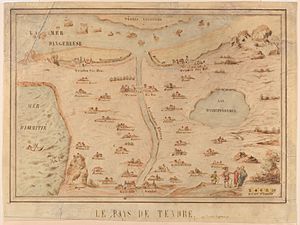Madeleine de Scudéry facts for kids
Quick facts for kids
|
|
|---|---|

Madeleine de Scudéry
|
|
| Born | 15 November 1607 Le Havre, Normandy, France |
| Died | 2 June 1701 (aged 93) |
| Language | French |
| Nationality | French |
| Genre | Roman à clef |
| Literary movement | Précieuses |
Madeleine de Scudéry (born November 15, 1607 – died June 2, 1701) was a famous French writer. People often called her Mademoiselle de Scudéry. She knew a lot about ancient history, so it's thought she studied Greek and Latin.
In 1637, after her uncle passed away, Madeleine moved to Paris. She lived with her brother, Georges de Scudéry, who was a playwright. Sometimes, Madeleine used her brother's name to publish her books. She quickly joined a group of smart women called the "précieuses" at the Hôtel de Rambouillet. Later, she started her own special gathering called the Société du samedi (Saturday Society). For many years, she was known as "Sapho" or by her own name. She was seen as one of the first "bluestockings" – a term for educated women interested in literature. She had a close friendship with Paul Pellisson that lasted until he died in 1693. Madeleine never married.
Madeleine's Early Life and Education
Madeleine de Scudéry was born in Le Havre, a city in northern France. She didn't have much money, but she received an excellent education. Her father, who was a port captain, died in 1613. Her mother passed away soon after.
Madeleine and her brother, Georges, were then cared for by their uncle. He made sure Madeleine got a very good education. She learned writing, spelling, drawing, dancing, painting, and needlework. On her own, Madeleine also studied farming, medicine, cooking, Spanish, and Italian.
Madeleine's Famous Books
Madeleine de Scudéry wrote very long novels. Some of her most famous ones include Artamène, ou le Grand Cyrus (10 books, 1648–53) and Clélie (10 books, 1654–61). These books were very popular across Europe. Even other famous writers, like Madame de Sévigné, praised them.
Artamène is one of the longest novels ever written, with about 2.1 million words! Her novels were long because they had endless conversations. They also featured many adventures, like heroines being kidnapped, but always told in a polite way. Readers at the time loved these novels because they gave hints about the lives of important people in society. These real people were often hidden as Persian, Greek, or Roman heroes and maidens. Madeleine de Scudéry even created a new type of novel called a roman à clef. This meant her stories had thinly disguised characters who were actually political or public figures.
Books About Women and Conversation
In Les Femmes Illustres (1642), Madeleine wrote to women and argued that education was more important than beauty for women to succeed in society. This book helped show why women should take part in discussions and writing. It used famous women speakers, like Cleopatra of Egypt, as examples.
Madeleine de Scudéry also wrote books about conversation. In Conversations Sur Divers Sujets (1680) and Conversations Nouvelles sur Divers Sujets, Dediees Au Roy (1684), she shared ideas on how to have good conversations in a salon. A salon was a special gathering where people discussed ideas. These books covered topics like "The Art of Speaking" and "The Manner of Writing Letters." They showed how women could lead intellectual discussions.
Madeleine's novels were usually set in ancient times or the "Orient." But their language and actions showed the popular ideas of the 1600s. The characters in her stories could be identified as people Madeleine knew. For example, in Clélie, Herminius was Paul Pellisson. In the description of Sapho in Le Grand Cyrus, Madeleine described herself.
In Clélie, Madeleine de Scudéry invented the famous Carte de Tendre. This was a map of a make-believe land where all the places were named after feelings and ideas about love. For example, the "River of Inclination" flowed past villages like "Billet Doux" (which means love letter). Madeleine was very good at conversation. Several books were published during her lifetime that claimed to share her conversations on different topics. She truly believed in teaching others.
Madeleine's Later Years
Madeleine lived more than thirty years longer than her brother. In her later life, she published many books of conversations. These were often taken from her novels, like a collection of her best ideas. Madeleine was deaf for the last 40 years of her life. Even though her books became less popular over time, she kept a group of close friends, like Marie Dupré. To them, she was always the "incomparable Sapho."
Madeleine's Lasting Impact
Madeleine de Scudéry was an important part of a movement in the 1600s. During this time, women in England and France started using old ideas about speaking and writing in new ways. She changed how people thought about discussions. Instead of public speeches, she favored conversation in a salon. In these gatherings, people would build on each other's ideas, aiming for agreement rather than argument. She is known as a key figure in the history of "salon" conversations and letter writing.
See also
 In Spanish: Madeleine de Scudéry para niños
In Spanish: Madeleine de Scudéry para niños


